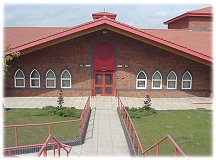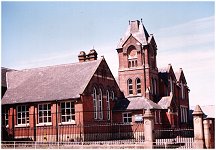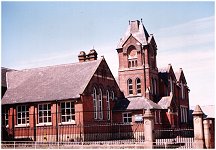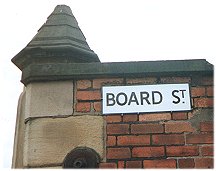
Pikes Lane School

The new Pikes Lane School today
The History of Pikes Lane School

The original Pikes Lane School
Why was Pikes Lane School Built?
The 1870 Education Act set up ‘school
boards’ which were responsible for the building and running of schools in
their own area. In 1872 a bill was
passed which stated that children must have received education until they were at
least 12 years old. The schools
boards appointed attendance officers to make sure children went to school.
Before this Act only children from wealthy families received education;
they either had governesses or went to fee-paying schools.
however, the majority of children from working class families received
little education before the 1870’s. They
went out to work when they were only 7 or 8 years old as not only could their
families ill afford to pay for education, they needed the money that the
children could earn. However,
children were always very poorly paid and the jobs they did were often highly
dangerous, such as climbing and cleaning chimneys, working in the mines, or
cleaning floors underneath machines in the mills.
The Education Acts of the 1870’s were far more effective in stopping
this exploitation than the Factory Acts had been.
Pikes Lane Board School

Pikes Lane Board School was the first purpose built board school in Bolton. It opened in June 1875, although the stone above the main entrance is dated 1874. To commemorate the opening of the school the street running parallel to the front yard of the school was named “Board Street”.

In the late 1800’s when Pikes Lane was built, the whole school was
probably taught in one big room. When
it opened there were over 900 pupils attending the school.
What does this tell you about the difference in class sizes?
|
Year |
Juniors |
Infants |
Total |
|
1887 |
882 |
399 |
1281 |
|
1968 |
340 |
295 |
635 |
|
1991 |
205 |
165 |
370 |
There would have been little equipment
and few books in the classroom. Much
of the teaching was done by repetition and while this reduced the need for books
it did not encourage pupils to ask questions or think for themselves.
They used slates to write on rather paper, as it was more economical and
could be wiped clean and used again and again.
However, the slates were fragile and cracked if dropped.
Children were severely scolded for breaking their slates.
In addition to the teachers, there would
have been older girls called pupil-teachers who were not much older than the
children they taught, and this was the first part of their training to become
teachers – one of the few careers open to women in the 1870’s
and 80’s. Some of the
children were ‘half-timers’ who went to work in the mornings and then went
to school in the afternoons.
Pikes Lane School in 1955
The school originally served heavily
populated areas of terraced houses to the south and west of the school, but many
of these old streets have been demolished. New houses and flats with gardens have replaced many of the
old terraces. The streets the east
of the school were built towards the end of the 1890’s to house the families
who moved into the area to work in the mills, factories and shops of the town.
Pikes Lane Junior School
There are three departments at Pikes Lane School; the nursery, infant and junior. The shape of the school buildings has changed several times since it opened.
Empire Day (now called Commonwealth Day)
The following extracts from the records
of Pikes Lane School describe the festivities which took place each year on
Empire Day. This day has been
officially recognised since 1902 when the Earl of Meath inaugurated the festival
as a means of training school-children in good citizenship.
May 24th was Queen Victoria’s birthday and used to be
observed as a school holiday in the British Empire.
It was also a memorial to the assistance given by the colonies to the
mother country in the South African War of 1899-1902.
It is known as ‘Empire Day’ until 1958 when its name was changed to
‘Commonwealth Day’ . it is not
celebrated in schools these days.
Children boarded the charabancs to take them on a school trip to Higher Hodder on Empire Day, in the 1930’s. The Hodder is a river between Blackburn and Preston. A charabanc was a long vehicle like a coach.
Extracts from Pikes Lane School
records:
On
21st May 1920 the children sang Empire songs and danced in the
playground and went home at 3.20 pm.
On
24th May 1923 the children were lined up in the playground and sang
patriotic songs for Empire Day. Most
children carried flags and many parents were present.
The National Anthem was sung and cheers brought the proceedings to a
close.
Asian Migration
The most noticeable changes in the
population of the Pikes Lane area came in the 1950’s and ‘60’s when Asians
arrived in this country. The exodus
from their countries of origin resulted as political situations there
deteriorated. Today the
residents in the neighbourhood comprise of three major groups of people; Hindus,
Muslins and English.
The majority of Hindus came from either
Uganda or Kenya. With the eruptions
of hostilities in Uganda any Indians living there had to move quickly, leaving
all their possessions. A great
number of families also came from Kenya as the political situation there led the
Asian middle-class families to sell almost everything they had and leave the
country. Fortunately they were
given a certain period of time in which to either register as Kenyan Citizens,
or leave their belongings and take up UK Citizenship.
They were thus able to sell their belongings and bring their money with
them to set up businesses or buy their own houses when they arrived.
Most Asians who came from Kenya were
either white-collar workers or businessmen and the society in Pikes Lane
catchment area mainly consists of bank clerks, businessmen, technicians, and
ex-teachers from East Africa or India. Many
of the Asians from Kenya, Uganda, Mauritius, Madagascar, Zambia and Burma
enjoyed a very high standard of living; they lived in beautiful spacious houses
or bungalows in comparison to the crowded conditions of living in a terraced
house. On moving to Britain the
majority of them were unable to secure the same type of employment as they had
in their own countries of origin and are at present engaged in inferior manual
occupations. This is due largely to
a problem of language. They are
very anxious for their children to be well educated, in the hope that they will
not have to undergo similar difficulties in finding suitable employment.
The Muslim community who live around Pikes Lane can be distinguished as two separate groups; the Surti Muslims from Pakistan, and the Baruchi Muslims from a little state called Baruch, in India. The majority of Muslims at Pikes Lane School have roots in Baruch as their parents were born in Baruch. Asians from some parts of Baruch and Kuch in India lived in inferior conditions there as the villages lack modern amenities. They came here hoping that there would be more opportunities and a better way of life. Some have become disillusioned, while others have found themselves both economically and socially better off in Britain and enjoy a better standard of living. Most families still make provision for their elderly parents aboard by sending money each month. This money is usually sufficient to provide food and clothing as well as someone to work for them.